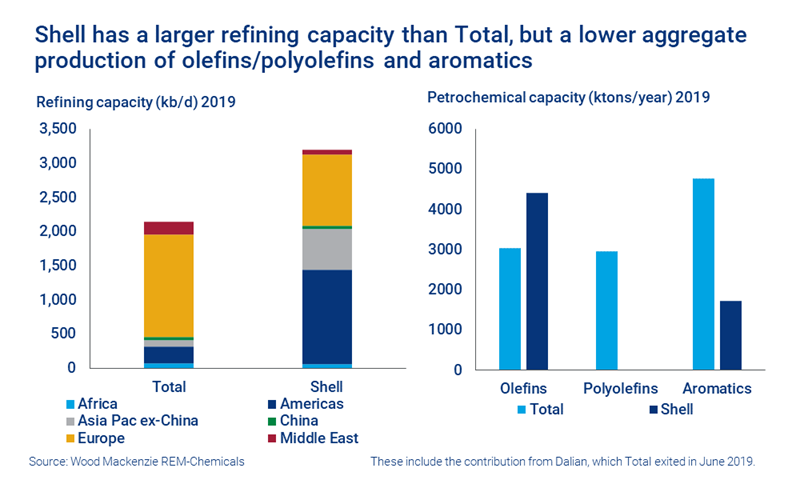How much value does refinery-chemicals integration add for Total and Shell?
Integration has become a strategic imperative, but measuring value is notoriously difficult
1 minute read
Alan Gelder
SVP Refining, Chemicals & Oil Markets

Alan Gelder
SVP Refining, Chemicals & Oil Markets
Alan is responsible for formulating our research outlook and cross-sector perspectives on the global downstream sector.
Latest articles by Alan
-
Opinion
The impact of the Israel-Iran conflict escalation on the global energy market
-
Opinion
Oil and refining market implications of Israel’s strike on Iran
-
Opinion
What is the impact of US tariffs on oil and refining?
-
Opinion
Oil and refined products in 2025: a commodity trader’s guide
-
Opinion
Global refinery closure outlook to 2035
-
The Edge
What a future Ukraine peace deal means for energy (Part 2)
Refining is a challenging business. And that’s never been more evident than in 2020.
The sharp drop in oil demand in the two months to April as a result of coronavirus restrictions temporarily wiped out almost 20 years of oil demand growth. And that hit the refining sector particularly hard. Global refining margins collapsed, and earnings took a significant knock.
While oil demand is recovering it will take a few years to get back to pre-crisis levels, with jet fuel potentially taking longer. To survive and remain relevant, large parts of the refining industry will need to adapt.
Even before coronavirus took a bite out of oil demand, integrating refineries with chemical facilities was a growing trend as companies strive to diversify earnings and maximise profit. The current crisis will only accelerate that trend as integration becomes a strategic imperative.
Integration has already proven that it can add significant value. But how does the industry benchmark success? Our experts crunched the numbers for Total’s integrated portfolio and looked at how that compared to Shell. Fill in the form to access this complimentary case study or read on for a brief introduction.
Tracking integration in action
Many first-generation integrated sites have been operating for decades. However, some of the Majors, such as Shell and Total, have shifted their focus to integration only more recently.
Both companies have focused on petrochemical’s contribution to their competitive refining portfolios and have started to close or divest weaker refining assets. Total has a limited number of standalone refineries, with the closure of Grandpuits already announced. Meanwhile, Shell plans to further reduce its refining portfolio from 20 to just 10 assets.
For both Majors, integrated sites are responsible for virtually all the value contribution across their downstream asset portfolios.
How does crude-to-chemicals integration add value?
In a variety of ways. Integration can allow a producer to switch product yields between refining and chemicals, depending on which products are more valuable at any given time, making margins more resilient. Also, sharing processes that overlap in a refining and chemical unit can generate cost synergies.
But measuring that value is challenging. Tracking and benchmarking value on an ‘apples to apples’ basis is extraordinarily difficult.
The benefits of integration vary by site, technology choice, scale and a host of other factors. Integration also increases the complexity of an operation. To fully understand the value that is created, you need to take an holistic view.
New benchmarks are needed
The tools the industry uses to benchmark facility competitiveness need to change. As integration as a strategy becomes more commonplace, we’re looking more closely than ever at the full picture of the margin and competitive position of entire petrochemical and refining sites, rather than just one primary chemical product.
That’s why we’ve created a new modelling technique to assess the changing refinery and chemicals market. Building on our refinery evaluation model (REM), REM-Chemicals expands site coverage across the olefins, polyolefins and aromatics chains, providing a broader perspective on integrated assets. This allows companies to more meaningfully benchmark against peers and assess an individual site’s competitiveness.
Find out more about REM-Chemicals.
How much value has integration added to Total’s refining portfolio?
Of Total’s nine integrated sites, we’ve evaluated the impact of integration on the bottom line of its Gonfreville refinery. Extending its facilities to include olefins and aromatics production has materially enhanced the site’s overall competitive position.
The site’s preliminary net cash margin (NCM) increases by almost $6/bbl, with EBITDA increasing $560 million when petrochemical products are incorporated.
How does that compare to the NCM figures for sites across Total’s portfolio? And has Shell performed better? Fill in the form at the top of this page to see our modelling tools in action.
Hear more from our experts at the Global Olefins Conference 2020
The petrochemical industry and broader energy sector have faced a series of unexpected challenges during 2020. Pressures abound from all sides with turbulent feedstock prices and a collapse in demand stemming from the global pandemic. This compounds an already uncertain outlook for the olefin and polymer industries, which were already facing a cyclical downturn and headwinds from increased sustainability efforts.
Join this virtual conference on 14 October to hear from our experts on what to expect in an increasingly complex world.

VP Refining, Chemicals & Oil Markets







